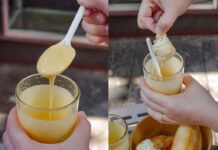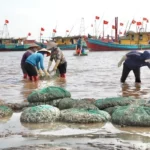A visit to Canh Duong Market in Canh Duong Commune, Quang Trach District, from 3 a.m. onwards reveals the bustling atmosphere of this traditional market. It is not just a place for ordinary exchange and trade but also a unique cultural space, preserving the values of the ancient fishing village that is over three centuries old.
The market begins with the sound of waves
Located at the mouth of the Roòn River, where freshwater meets the East Sea, Canh Duong Market is about 50km north of the city of Dong Hoi. This advantageous location has made it a crucial transshipment point for seafood in the region, connecting local fishermen with traders from many central provinces.
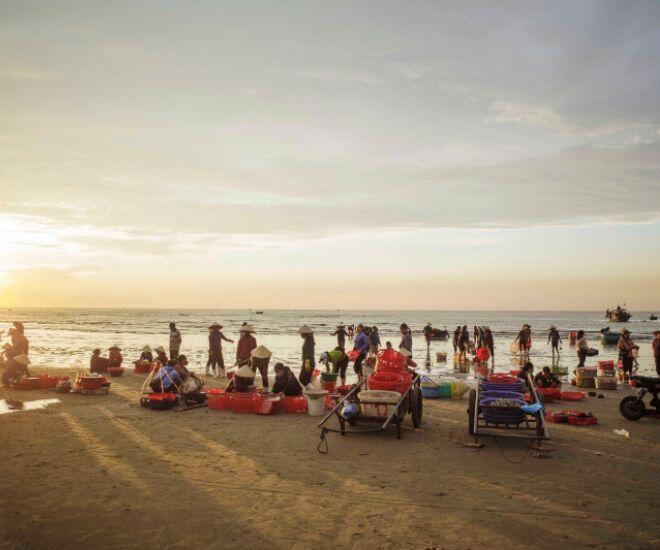
From 3 a.m., when the first fishing boats arrive, the market starts to buzz with activity and usually wraps up before 8 a.m. This has been the daily rhythm of Canh Duong residents for generations.
Architecturally, the market exudes the rustic charm of a fishing village with rows of tin-roofed shops temporarily set up along the seaside. The unique highlight is the interspersed honey-colored stone houses – a rare architectural heritage of the central coastal region.
The market area is logically divided into two main sections: the fresh seafood section near the boat landing, where fishermen return from their voyages; and the culinary and specialty section, featuring dishes prepared on-site and fermented products such as fish sauce and dried seafood.
A historical journey spanning over three centuries
Canh Duong Market’s history is intertwined with the formation of the Canh Duong fishing village in 1643 during the Le Trung Hung period. Initially, it was just a small exchange point among fishing households, eventually developing into a bustling trade center due to its favorable location.
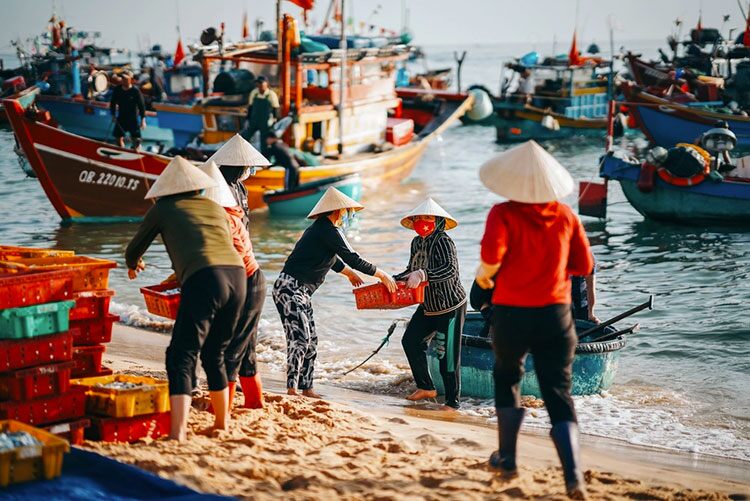
Notably, in the 17th and 18th centuries, Canh Duong Market became the supplier of Ham Huong fish sauce, a specialty presented to the King of the Later Le Dynasty. Historical records indicate that the villagers had to pay an annual tribute of 400 jars of fish sauce made from Long Chinh fish (also known as Ham Huong fish) – a small fish found only in the Roòn estuary. This fact cemented Canh Duong’s place in history as a renowned traditional craft village with a unique product.
Today, although the market’s scale has expanded significantly, the trading activities retain their traditional essence, reflecting respect for the long-standing history and culture of this fishing village.
Abundant and delicious seafood
Canh Duong Market is famous for its diverse range of fresh seafood caught in the local sheltered sea. Visitors can easily find grouper with white, chewy, and sweet meat (priced between 350,000 and 450,000 VND/kg); squid, renowned for its exceptional freshness and sweetness due to the clean seawater (ranging from 150,000 to 250,000 VND/kg); and baby lobsters, perfect for grilled dishes with chili and salt (varying from 500,000 to 700,000 VND/kg).
In addition to fresh seafood, the market’s processed specialties are also noteworthy. The most prominent is Ham Huong fish sauce, made from Long Chinh fish fermented with sea salt according to a secret family recipe, imparting a mild saltiness and distinctive aroma unavailable elsewhere. This royal delicacy is now sold at a price ranging from 200,000 to 300,000 VND for a 500ml bottle.
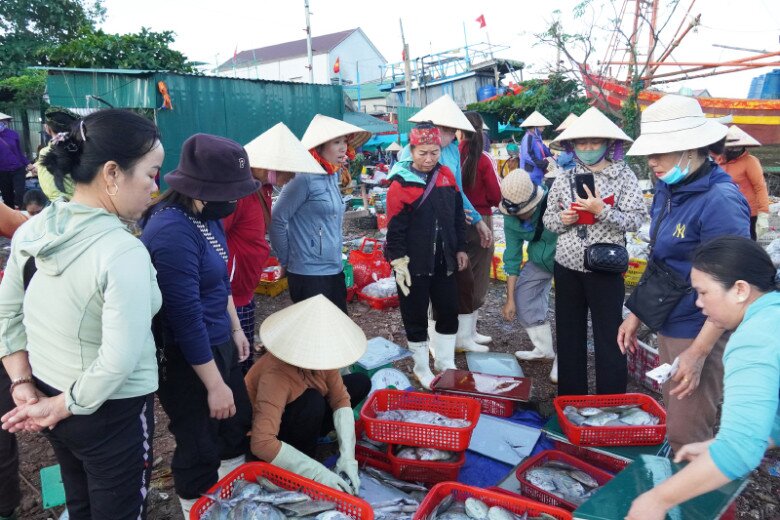
Dried stingray, naturally sun-dried and commonly used for sour soup or grilling, is another specialty sought after by tourists, priced at approximately 150,000 VND/kg. Moreover, fish sauce made from coal scad with a high degree of nitrogen (40°N) and sold at 50,000 VND/liter is also a typical product of the market.
Unique culture amidst the seaside market
What sets Canh Duong Market apart from other fish markets is the dominant role of women in trading activities. From sorting and pricing to negotiating, the women of Canh Duong exhibit dexterity and decisiveness – a result of the centuries-old tradition of “men going to sea, women keeping the market.”

Canh Duong Market is also associated with Canh Duong lullabies, a national intangible cultural heritage. The uniqueness of this folk art lies in the participation of both women and men, with lyrics reflecting the labor and deep love for the sea.
Annually, during the Cau Ngu Festival (held in the third lunar month), the market becomes the epicenter of distinctive cultural activities such as traditional boat racing competitions, exhibitions of ancient fishing tools, and performances of lullabies and “ba trao” dancing – all contributing to the preservation of the region’s unique marine cultural identity.
Tips for visiting and shopping
For visitors eager to immerse themselves in the vibrant atmosphere of Canh Duong Market, the ideal time is between 3 and 5 a.m. – when the fishing boats arrive, offering the freshest seafood options. Alternatively, from 6 to 7 a.m., which is the end of the market day, is perfect for buying in bulk at discounted prices.
Some negotiation tips for shopping at the market: when buying in wholesale quantities (5 kg or more), prices can be reduced by 10% to 15%. For example, squid priced at 250,000 VND/kg may drop to 210,000 VND/kg when purchasing 10 kg. When checking the quality of products, especially Ham Huong fish sauce, the standard product usually has a brown color, a mild aroma, and no lumps.
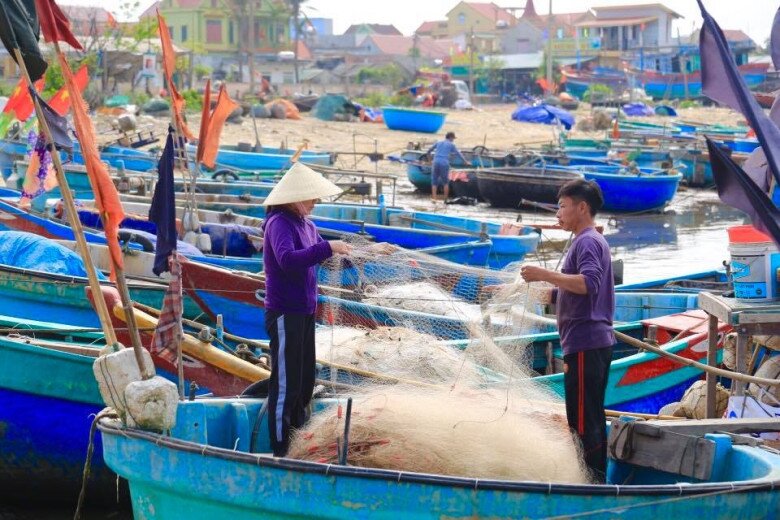
From a cultural perspective, visitors should be mindful of local customs and dress modestly, avoiding revealing clothing. In communication, it is advisable to use polite language and avoid haggling too aggressively, especially when most sellers are elderly women.
A living heritage in need of preservation
According to a report by the People’s Committee of Canh Duong Commune (2025), the catch volume in recent years has significantly decreased, specifically a 30% drop compared to 2010. The main reasons cited are environmental pollution and over-exploitation. This directly affects the market’s supply and threatens the traditional livelihood of the fishing community.
To adapt to the new situation, the local government has implemented the “Canh Duong Market – A Heritage Destination” project with practical activities such as organizing morning market tours combined with fish sauce-making experiences; establishing an exhibition area for ancient fishing tools; and training local tour guides proficient in foreign languages like English and French.
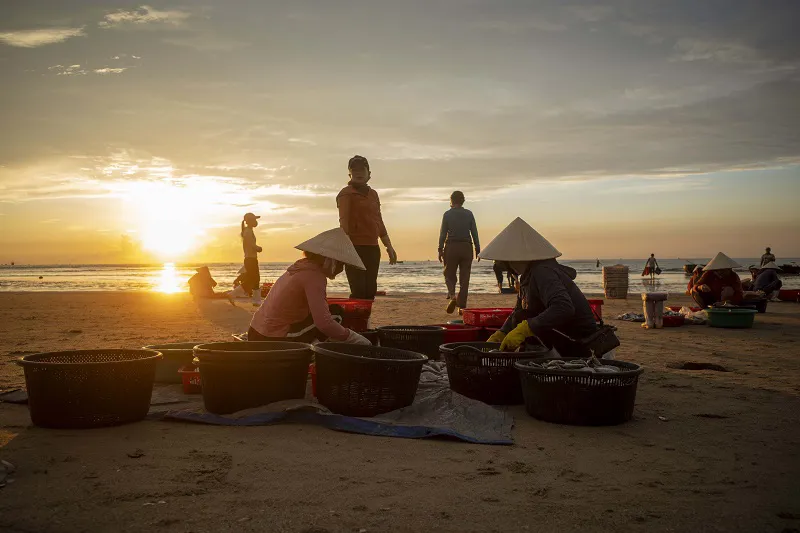
Developing tourism linked to cultural heritage preservation is considered a sustainable approach, helping the local community maintain their livelihood amid declining fisheries resources while introducing the unique cultural values of Canh Duong fishing village to domestic and international visitors.
Canh Duong Market is more than just an economic space; it is a repository of the cultural heritage of Quang Binh’s fishing villages. From the rich flavors of Ham Huong fish sauce to the soothing lullabies echoing through the early morning market, every element here embodies the spirit of labor and creativity of the coastal community.
With a history spanning over 380 years, Canh Duong Market is undoubtedly a precious cultural heritage of Quang Binh and the central coastal region – a place that not only preserves material values but also embodies the spirit, identity, and soul of Vietnam’s fishing villages.
The Heart of Tuyen Quang: A Glimpse into Vietnam’s Most Charming Rural Market
Nestled under the canopy of a centuries-old banyan tree, the Tua Lu Multi-century Market in Tan Thanh Commune, Son Duong District, Tuyen Quang Province has become an iconic cultural landmark in the northern mountainous region of Vietnam. With a history spanning hundreds of years and set against a backdrop of majestic natural scenery, this market is not just a hub for trade but also an emerging tourist destination that has captured the interest of many.
Explore the Ultimate Seafood Market in Quang Ninh, Brimming with Freshly Caught Fish and Squid, at Unbeatable Prices
Hòn Gai Fish Market, also known as Ha Long’s early morning fish market, is a must-visit destination when in Quang Ninh. Nestled at the foot of Bai Tho Mountain, right next to the Hon Gai port, this bustling marketplace is not just a hub of commercial activity for local fishermen but also a treasure trove of rich cultural traditions unique to the coastal region.
The Power of Tết: Instilling Values of Love and Family Unity in Children
Introducing: Unveiling the Traditions of Tet – A Guide to Teaching Your Children About Lunar New Year.
Tet, or Lunar New Year, is a time-honored tradition celebrated by millions worldwide. It’s a festival steeped in history, culture, and symbolism. This guide aims to unravel the mysteries of Tet, providing parents with the tools to teach their children about this vibrant and joyous occasion. By understanding the significance of Tet, your family can embrace and cherish this special time, passing on a rich cultural heritage to future generations.


















